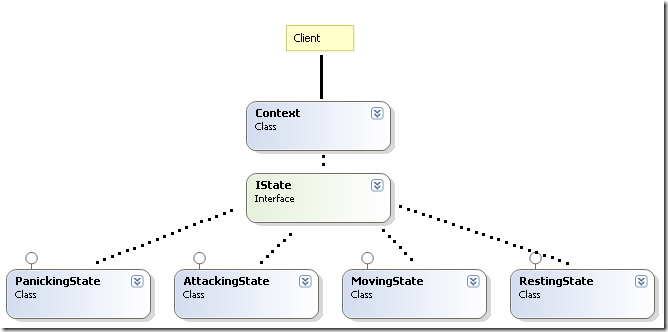Continuiamo con lo smell: Primitive Obsession

Problema:
Gestire le condizioni dello stato di un oggetto è complicato e complesso.
Un esempio di logica errata:
while (command != 'e')
{
Console.WriteLine("\nWhat would you like to do now?");
Console.Write("Move Attack Stop Run Panic CalmDown Exit the game: ==>");
string choice;
do
choice = Console.ReadLine();
while (choice == null);
command = choice[0];
switch (char.ToLower(command))
{
case 'm':
if (ply.CurrentState == "Stop" || ply.CurrentState == "CalmDown")
ply.CurrentState = "Move";
else
Console.WriteLine("You need to stop moving first!!!");
break;
case 'a':
if (ply.CurrentState == "Stop" || ply.CurrentState == "CalmDown")
ply.CurrentState = "Attack";
else
Console.WriteLine("You need to stop moving first!!!");
break;
case 'p':
ply.CurrentState = "Panic";
break;
case 'e':
Console.Write("Thank you for playing!");
break;
default:
Console.Write("Error, try again");
break;
}
}
|
Motivazione:
La prima motivazione al refactoring di questo codice è quella di controllare l’espansione esponeziale delle condizioni di controllo che si andranno a creare/aggiungere.
Tramite lo State pattern, si creerà una classe che si occuperà di gestire tutti gli stati di transazione dell’oggetto.
Soluzione:
Ecco come si mostrerà il codice di sopra applicando il State:
public class Context
{
public IState State { get; set; }
public void Request(char c)
{
string result;
switch (char.ToLower(c))
{
case 'm': result = State.Move(this); break;
case 'a': result = State.Attack(this); break;
case 's': result = State.Stop(this); break;
case 'r': result = State.Run(this); break;
case 'p': result = State.Panic(this); break;
case 'c': result = State.CalmDown(this); break;
case 'e':
result = "Thank you for playing \"The RPC Game\"";
break;
default:
result = "Error, try again";
break;
}
Console.WriteLine(result);
}
}
public interface IState
{
string Move(Context context);
string Attack(Context context);
string Stop(Context context);
string Run(Context context);
string Panic(Context context);
string CalmDown(Context context);
}
// There are four States
class RestingState : IState
{
public string Move(Context context)
{
context.State = new MovingState();
return "You start moving";
}
public string Attack(Context context)
{
context.State = new AttackingState();
return "You start attacking the darkness";
}
public string Stop(Context context)
{
return "You are already stopped!";
}
public string Run(Context context)
{
return "You cannot run unless you are moving";
}
public string Panic(Context context)
{
context.State = new PanickingState();
return "You start Panicking and begin seeing things";
}
public string CalmDown(Context context)
{
return "You are already relaxed";
}
}
class AttackingState : IState
{
public string Move(Context context)
{
return "You need to stop attacking first";
}
public string Attack(Context context)
{
return "You attack the darkness for " + (new Random().Next(20) + 1) + " damage";
}
public string Stop(Context context)
{
context.State = new RestingState();
return "You are calm down and come to rest";
}
public string Run(Context context)
{
context.State = new MovingState();
return "You Run away from the fray";
}
public string Panic(Context context)
{
context.State = new PanickingState();
return "You start Panicking and begin seeing things";
}
public string CalmDown(Context context)
{
context.State = new RestingState();
return "You fall down and sleep";
}
}
class PanickingState : IState
{
public string Move(Context context)
{
return "You move around randomly in a blind panic";
}
public string Attack(Context context)
{
return "You start attacking the darkness, but keep on missing";
}
public string Stop(Context context)
{
context.State = new MovingState();
return "You are start relaxing, but keep on moving";
}
public string Run(Context context)
{
return "You run around in your panic";
}
public string Panic(Context context)
{
return "You are already in a panic";
}
public string CalmDown(Context context)
{
context.State = new RestingState();
return "You relax and calm down";
}
}
class MovingState : IState
{
public string Move(Context context)
{
return "You move around randomly";
}
public string Attack(Context context)
{
return "You need to stop moving first";
}
public string Stop(Context context)
{
context.State = new RestingState();
return "You stand still in a dark room";
}
public string Run(Context context)
{
return "You run around in cirles";
}
public string Panic(Context context)
{
context.State = new PanickingState();
return "You start Panicking and begin seeing things";
}
public string CalmDown(Context context)
{
context.State = new RestingState();
return "You stand still and relax";
}
}
static class Program
{
// The user interface
static void Main()
{
// context.s are States
// Decide on a starting state and hold onto the Context thus established
Context context = new Context();
context.State = new RestingState();
char command = ' ';
Console.WriteLine("Welcome to \"The State Game\"!");
Console.WriteLine("You are standing here looking relaxed!");
while (command != 'e')
{
Console.WriteLine("\nWhat would you like to do now?");
Console.Write(" Move Attack Stop Run Panic CalmDown Exit the game: ==>");
string choice;
do
choice = Console.ReadLine();
while (choice == null);
command = choice[0];
context.Request(command);
}
}
}
|

Benefici e non
+ Rimuove o riduce le logiche di cambio di stato.
+ Semplifica condizioni di stato complesse.
+ Aiuta a semplificare il design centralizzando il cambio di stato in un unico punto dell’applicazione.
- Complica il design se le condizioni di cambio di stato sono alquanto semplici/poche. |
E non prendete come scusa: “il mio sistema ormai è troppo evoluto per poterne apportare queste migliorie. E’ troppo tardi.”
Se fosse realmente così non esisterebbe il Refactoring :)
Per questo post ho preso spunto da libro Refactoring To Patterns di Joshua Kerievsky.
posted @ martedì 26 maggio 2009 15:42